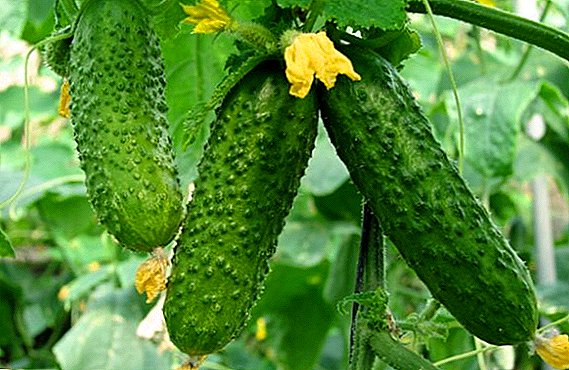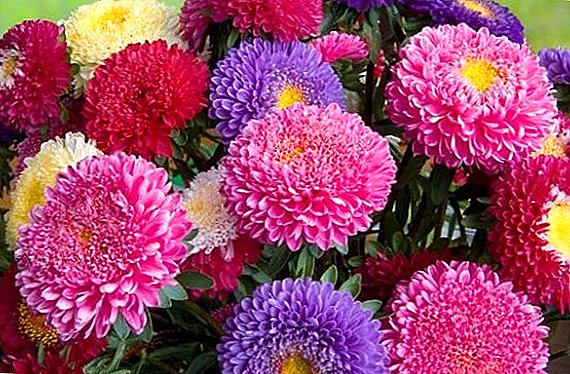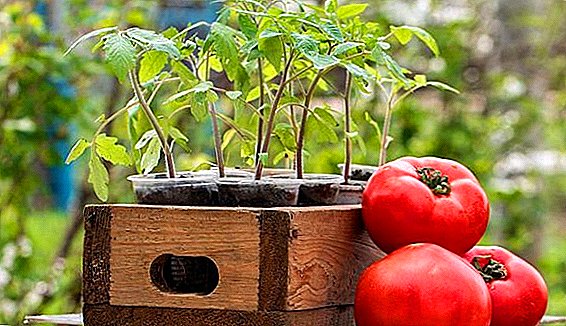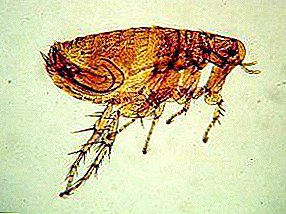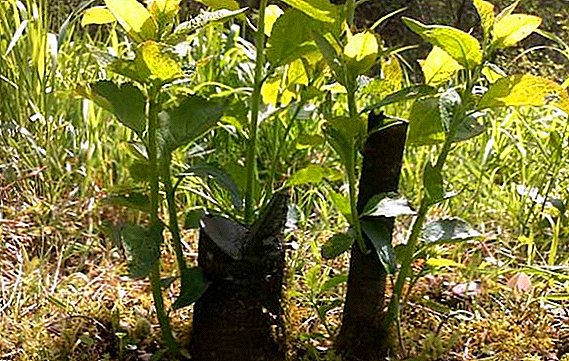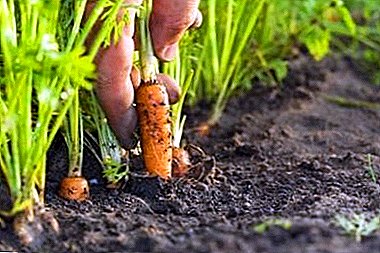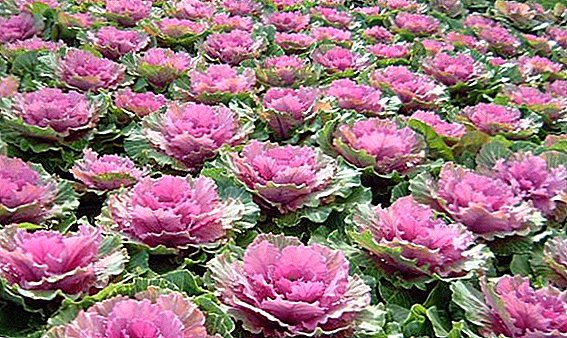 Who would have thought that the cabbage known to all can be grown not only for gastronomic purposes, but also as decoration for your plot. Of course, this is not about the standard head of this vegetable, but about an ornamental plant, which today has a lot of varietal variations. What is remarkable such cabbage and how to grow it properly - read on.
Who would have thought that the cabbage known to all can be grown not only for gastronomic purposes, but also as decoration for your plot. Of course, this is not about the standard head of this vegetable, but about an ornamental plant, which today has a lot of varietal variations. What is remarkable such cabbage and how to grow it properly - read on.
Culture description
The cabbage for decorative breeding, about which we will tell about planting and care a little later, is a biennial plant up to 80 cm high (sometimes even more). Depending on the variety chosen, the color of the leaves can vary from emerald green and bluish green to pale pink, peach or deep purple. Sheet plates are characterized by quite impressive dimensions, since their width is often 30 cm with a length of 60 cm.
The development of culture ends closer to the end of the summer, although with its appearance it may make you happy even half of autumn.
Important! In the first year after planting, decorative leaves form leaves, but it can only bloom and bear fruit the next.Taking into account the possible curliness of the leaves, all the bushes should be divided into festoon-like coarse-curled, moss-curly and festoonoobrazno-thin-curly.
Mature plants have a fairly high level of frost resistance and can safely tolerate a decrease in temperature to -12 ° C, while seedlings withstand only up to -4 ° C. 
Popular varieties
In the old days, the described type of cabbage was attributed to fodder plants, but the time came when its large flowers aroused interest among botanists and breeders. Since that time, the selection of plants began, thanks to which today there are two main decorative types of this vegetable: rosette and tall.
Familiarize yourself with such cabbage representatives as cauliflower, Peking cabbage, Kale cabbage, white cabbage, savoy, Chinese.The first group includes plants, the shape of which more closely resembles an ordinary garden crop, with a short stem. However, the leaves of her fold into a huge outlet, so that it turns a beautiful flower. It is this species that has gained the most popularity, so it is not a problem to meet it. The varieties of rosette decorative cabbage include the following (photos and names already testify to their beauty):
- "Tokyo" - represented by small plants, reaching 30 cm in height. They have a very bright middle, contrasting well with the dark green lower leaves of a rounded shape.
- "Osaka" - is characterized by pink or white leaves (can be strongly corrugated or generally straight), outwardly similar to the previous variety. The socket reaches 45 cm in diameter and 60 cm in height.
- "Nagoya "- a powerful plant with densely fringed red or white leaves. The rosette reaches 60 cm in diameter.
- "Lace frill" - grows up to 50 cm in height and has very beautiful lace leaves.
 By the tall type of decorative cabbage include plants whose shape resembles a palm tree. Adult specimens are characterized by the presence of a tall, slender stem with large, beautifully hanging leaves. The color of the leaf plates can vary from dark green to white (with different shades). Thanks to the painstaking work of breeders, now it is possible to grow varieties with curly, lace and corrugated leaves, which will become a real decoration of your garden or flower bed. When choosing plants of this species should pay attention to these popular varieties:
By the tall type of decorative cabbage include plants whose shape resembles a palm tree. Adult specimens are characterized by the presence of a tall, slender stem with large, beautifully hanging leaves. The color of the leaf plates can vary from dark green to white (with different shades). Thanks to the painstaking work of breeders, now it is possible to grow varieties with curly, lace and corrugated leaves, which will become a real decoration of your garden or flower bed. When choosing plants of this species should pay attention to these popular varieties:- "Red high" - the diameter of the bush reaches 70 cm, purple leaves are located around the stem.
- "The language of the lark" - different beautiful dark green, corrugated and elongated leaves.
- "Mosbakhskaya" - the plant has a dome-shaped form, with a stem height from 20 to 60 cm. The leaves are yellowish-green and very bright, strongly curly at the edges.
Did you know? For the first time the Greeks turned their attention to the wild cabbage, starting to cultivate it in the IV century BC. e.Many gardeners prefer other, equally attractive varieties of ornamental cabbage, such as, for example, Sunrise, Purple Pigeon, Pink Heron, Blue Giant, etc.

Features of growing
Seedlings are best suited for growing ornamental cabbage. Considering the fact that the seeds of the plant are rather large and there are not so many of them in the bag, it is better to sow the seed material in small pots, so as not to bother with their transplant in the summer (after “transshipment” they take root rather quickly).
It is recommended to sow the culture at the end of March or early April, and by the end of the second month of spring, sprouted seedlings can be transported to the dacha and placed on the lightest window sill, although if weather conditions allow, it will be good for the street.
Light frost young plants are not afraid, but an excess of heat, supplemented by a lack of light, can lead to a strong forcing cabbage.
If you do not want to "play with pots", then you can sow the seeds right on the site, waiting for the snow to fall (usually this procedure is performed in the middle of April). Crops must be covered with foil, and as soon as they grow enough (this time falls on May), it will be possible to transplant them to another part of the garden (if this is really so necessary).
Of course, for any planting, it is important to take into account the requirements of ornamental cabbage to the characteristics of the place and soil, otherwise its cultivation, even with the most wonderful care, will not bring the desired result.
Choosing a place
Almost all varieties of the described culture are distinguished by a high level of light-loving, although they feel good in the conditions of partial shade, especially if you are not worried about its dimmer coloring and smaller sizes.
When choosing a place to plant, be sure to consider the size of the garden, and, of course, your own preferences. While some gardeners do not cease to consider a plant as a vegetable, planting in their garden, others refer to decorative cabbage more as to decorate their flower beds or gardens.  Annual and perennial flowers can become neighbors in a flower bed, which, like cabbage, will reach its maximum decorative value closer to the beginning of autumn.
Annual and perennial flowers can become neighbors in a flower bed, which, like cabbage, will reach its maximum decorative value closer to the beginning of autumn.
In general, growing a culture in large pots is considered the most appropriate option, since with a container volume of 10-15 liters, it develops well. Three seeds can be sown in each such container, after which, until they reach a decorative appearance, it is easy to remove them somewhere to one side so that they do not interfere.
Important! If you plan to keep the cabbage in the container permanently, the land should be watered regularly (during an especially hot period - every day) and fertilize at least 1 time per week.
The soil
Decorative cabbage feels great on sandy and loamy soils, and to get the best possible result and to achieve a high level of decorativeness, the site for planting should be prepared in the fall.  It is at this time that fertilizers are applied to the soil (3-4 kg of compost, 20 g of ammonium sulphate, 15 g of potassium chloride and 42 g of superphosphate are accounted for 1 m²).
It is at this time that fertilizers are applied to the soil (3-4 kg of compost, 20 g of ammonium sulphate, 15 g of potassium chloride and 42 g of superphosphate are accounted for 1 m²).
The composition obtained as a result of mixing should be embedded in the soil, and if it also has an increased level of acidity, then lime should be added to the listed components.
With the arrival of spring, before planting a decorative cabbage, the soil on the site is again loosened and leveled. It is advisable to select the places where before the cabbage (albeit decorative) grew tomatoes, legumes, onions, roots and cucumbers.
How to grow seedlings?
Any cabbage, both decorative and ordinary, when growing from seeds, will require some specific knowledge from you, and this is not only information about when to plant it.  First of all, attention should be paid to the issue of seed and soil preparation, which will be used in the initial stages (suppose you use pots).
First of all, attention should be paid to the issue of seed and soil preparation, which will be used in the initial stages (suppose you use pots).
Seed and soil preparation
In modern flower shops, there is simply a huge selection of seeds of different varieties of ornamental cabbage, which means that even the most demanding summer resident will be able to choose a specific option for his plot (just look at the photo on the package).
Did you know? Ornamental cabbage grows much faster than ordinary fodder planted in the garden.In order for seeds to grow well and soon show good results, following the advice of experienced summer residents, they need to be properly prepared for planting. For example, you can soak the seed in ordinary clean water, but with a small addition of organic fertilizer.
 It is easy to complete the task: take a piece of bandage or gauze and moisten it well in the mixture indicated, then level and place the seeds on top. Matter with the future cabbage must be moved to a cool, dark place and left there for about a week.
It is easy to complete the task: take a piece of bandage or gauze and moisten it well in the mixture indicated, then level and place the seeds on top. Matter with the future cabbage must be moved to a cool, dark place and left there for about a week.As soon as the seeds "naklyututsya", you can immediately proceed to their landing in the prepared ground.
For decorative cabbage planted on seedlings, a substrate that contains sand, peat and part of the usual soil (2: 1: 2) is perfect. If possible, it is better to prepare the land in advance by digging it in the garden or in the garden.
It will also be useful to treat it with a weak manganese solution: for only 1 cup of water, only a few crystals of potassium permanganate are enough to give the liquid a faint pinkish tint. 
Landing pattern
The seeds of cabbage of a decorative type are placed in a pre-loosened soil, adhering to the 5 × 5 cm scheme. As soon as the first shoots appear, the crops should be thinned, leaving only the strongest to grow.
As the soil dries, the plants water and repeat the loosening of the soil. The seedlings can be transplanted to a permanent place of growth in 30-45 days from the moment of planting. At the new site, seedlings are placed according to scheme 70 by 70 cm.
Planting seedlings in open ground and subsequent care
Sooner or later you will have to transplant plants from pots to a permanent place of their growth. It will be a separate territory in the garden or part of the flower bed - you decide, but in any case it is important to know how this task is performed correctly. 
Transplantation of cabbage
Immediately I must say that the ornamental varieties of cabbage tolerate transplantation quite well, and if you have a large earthy coma, you can perform this procedure 2-3 times for the entire period of growing the plant.
Try to carefully get each of them from the "home" place, trying not to damage the roots, and then carefully place it in the prepared pit (its diameter should be slightly larger than the diameter of the earth coma).
Did you know? Cabbage juice is widely used in cosmetology, as it has a rejuvenating effect.You can help your cabbage to take root in a new place with the help of dressings with a 1.5% fertilizer solution, for example, Kemira-Lux. As we already mentioned, the landing pattern in open areas is 70 × 70 cm.

Care features
After planting on your site you will find further care for them, which, by the way, is not very complex. The main requirement is regular and abundant watering, but in order to simplify your task and not to resort to the procedure too often, you can simply mulch the soil.
Grass, hay or wood chips will help to retain moisture in the soil; moreover, a layer of such material will protect your cabbage from the presence of a large amount of weed grass.
It is also important to maintain the soil in a loose state, and to exclude or prevent the development of diseases in a timely manner or to detect pests - carefully examine all the plants every day.
Flowering decorative cabbage falls around mid-summer and lasts until October.  However, in order to maintain its presentable appearance all this time, it will not be possible to do without timely dressing and weed (as with conventional specimens, this cabbage forms a rather heavy rosette, which makes it necessary to maintain the stem in a steady state).
However, in order to maintain its presentable appearance all this time, it will not be possible to do without timely dressing and weed (as with conventional specimens, this cabbage forms a rather heavy rosette, which makes it necessary to maintain the stem in a steady state).
As for fertilizer application, at the beginning of active leaf growth (that is, in June) plants are fed with a mullein extract, after which they take a short break and feed the mixture again (the composition is based on 1 part of organic matter per 10 parts of water).
It is strongly not recommended to add manure to the soil, as though the leaves will become very large, but the overall decorative effect will decrease (the color of the leaves will be mostly green).
Mineral fertilizers (for example, nitroammofosku) can be purchased in specialized stores, then dissolve 20 g of the substance in a bucket of water and water all the seedlings. 
Pest and disease control
More than the rest of the pests, ornamental cabbage varieties are plagued by slugs, root fleas and caterpillars, although they harm mainly young plants, and those that have become stronger are not so terrible.
Learn more about cabbage diseases.Ash, pepper and tobacco applied to the plants by dusting the crops after irrigation will help to get rid of the flea beetles (they need to be stuck to the leaves). Also well washes away small pests by sprinkling, although they still return with time.
To get rid of slugs will help the dressing of the earth with finely crumbled egg shells, needles or the same ash, but, in truth, they are rarely found in flower beds, especially in rainy time.  Scare away butterflies will help planting between cabbage marigolds, which at the same time will decorate the flower bed, until the cabbage reaches the peak of its decorative effect. A similar protective function is performed by some other plants: basil, calendula and dill.
Scare away butterflies will help planting between cabbage marigolds, which at the same time will decorate the flower bed, until the cabbage reaches the peak of its decorative effect. A similar protective function is performed by some other plants: basil, calendula and dill.
In case of mass destruction by slugs and caterpillars, they will have to be collected from the beds manually, although if decorative cabbage is not used for food, then the use of proven toxic chemicals remains the most effective way to prevent and control pests.
Regular crop rotation, maintaining the required level of soil acidity and the periodic use of microbiological preparations will help to avoid damage to plantations by root diseases (for example, by the keel or fomoz).
Is it possible to eat decorative cabbage?
Decorative cabbage is quite possible to eat, but only leafy forms of culture are distinguished by the highest taste. At the head of decorative type, the leaves are somewhat rougher than those of the table, but they can still be used for the preparation of cabbage rolls or first courses.  The leaves are slightly bitter, but to get rid of the bitterness, you just need to freeze the plant.
The leaves are slightly bitter, but to get rid of the bitterness, you just need to freeze the plant.
In late autumn, ornamental cabbage turns out to be a real find when feeding domestic animals, among which rabbits burn with a special love for the plant.
When there are so few healthy and nutritious crops left on the street, the leaves of ornamental cabbage will become a real well of vitamins.
As you can see, by putting quite a bit of effort, you will not only get a beautiful addition to your garden and vegetable garden, but also be able to extract practical benefits from the cultivation of an ornamental vegetable, so in any case, you should consider the possibility of planting decorative cabbage.



